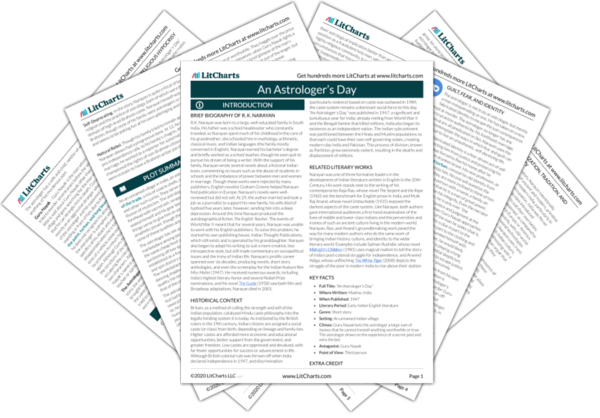The astrologer’s garb and equipment—including cowrie shells and mystical looking charts—represent the artificiality of much religious practice and, in turn, the ability to take advantage of people’s desire for faith. Using his clothing and wares like a costume, the astrologer offers to tell people the truth yet gives only vagaries produced by sharp observational skills and a practiced mind. His customers are rarely skeptical of the astrologer, having been sold on the truth of his words before he even says them due the compelling, seemingly holy nature of his appearance.
In the greater meaning of the story, the astrologer’s garb speaks to Narayan’s perception of the mystics and holy men in India and the position that religion holds in that culture. The greatest deception of the astrologer’s garb is that it transforms the astrologer, in the eyes of his customers, into a figure of divinity, something otherworldly, powerful, and pure. This suits the astrologer’s purposes, as no one thinks to question the integrity of a holy man. Yet the astrologer, like every other simple, common person that he interacts with, is just a man. He is prone to the same ills that he identifies in his customers: problems with money, marriage, or twisted human affairs. The astrologer’s garb, as a symbol, thus prods at the role of religion and religious men in India, reminding the reader that they are nothing more than human—as petty, greedy, and selfish as anyone else. In the Indian caste system, where the religious leaders rule the social order, this is a particularly poignant jab at the egos of the elite. While Narayan is not putting religion itself down with the use of this symbol, he is at the very least injecting it with a sharp dose of reality and speaking against the deification of mere men.
The Astrologer’s Garb and Equipment Quotes in An Astrologer’s Day
His forehead was resplendent with sacred ash and vermillion, and his eyes sparkled with a sharp abnormal gleam which was really an outcome of a continual searching look for customers, but which his simple clients took to be a prophetic light and felt comforted. The power of his eyes was considerably enhanced by their position—placed as they were between the painted forehead and dark whiskers which streamed down his cheeks: even a half-wit’s eyes would sparkle in such a setting.
To crown the effect he wrapped a saffron-colored turban around his head. This color scheme never failed. People were attracted to him as bees are attracted to cosmos or dahlia stalks. He sat under the boughs of a spreading tamarind tree which flanked a path running through the Town Hall Park.












